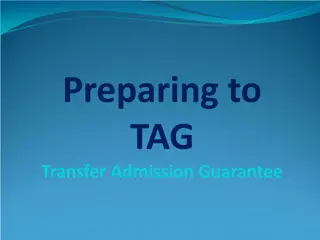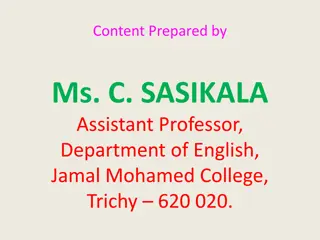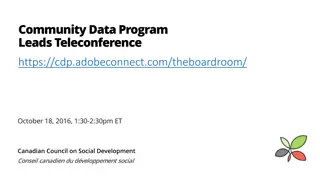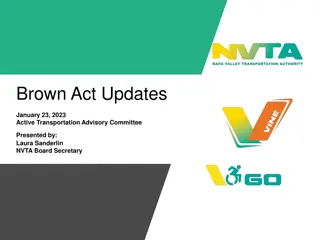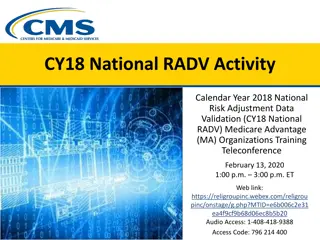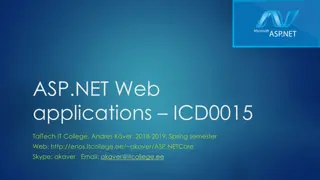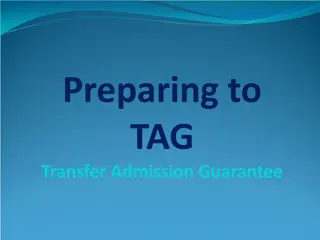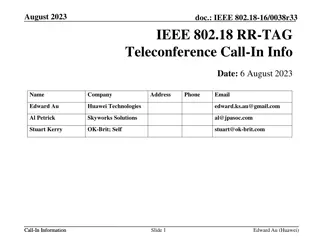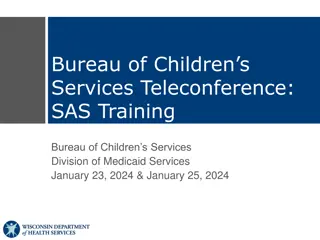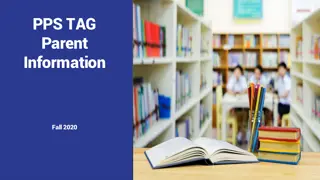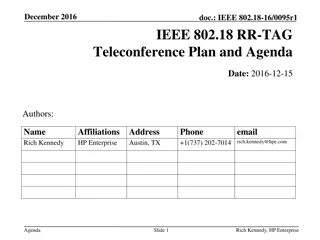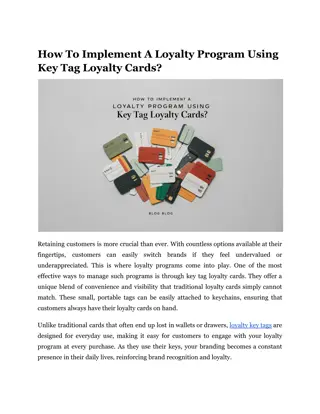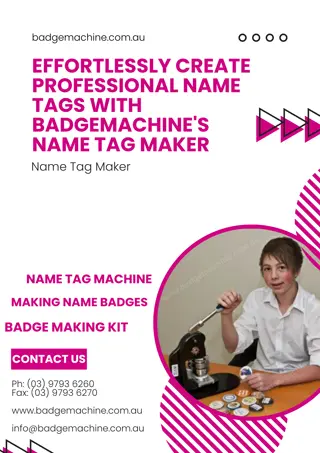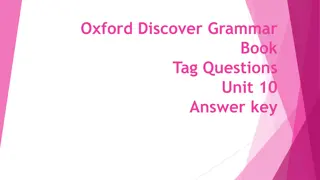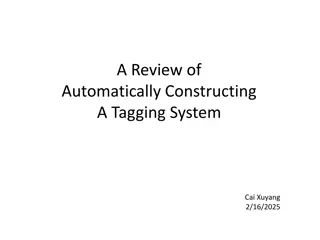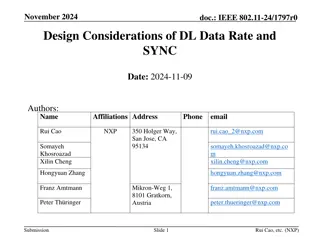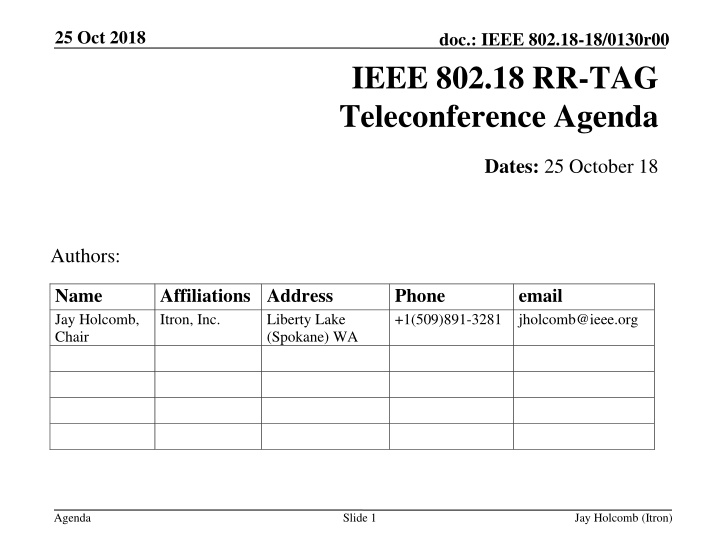
IEEE 802.18-18 RR-TAG Teleconference Agenda Summary
Detailed agenda for an IEEE 802.18-18 RR-TAG teleconference meeting held on October 25, 2018, including administrative items, guidelines for IEEE WG meetings, and participation requirements. The agenda covers important information like officer appointments, quorum requirements, meeting conduct guidelines, and antitrust policies. Members are expected to participate as individuals, uphold ethical standards, and comply with IEEE-SA regulations.
Download Presentation

Please find below an Image/Link to download the presentation.
The content on the website is provided AS IS for your information and personal use only. It may not be sold, licensed, or shared on other websites without obtaining consent from the author. If you encounter any issues during the download, it is possible that the publisher has removed the file from their server.
You are allowed to download the files provided on this website for personal or commercial use, subject to the condition that they are used lawfully. All files are the property of their respective owners.
The content on the website is provided AS IS for your information and personal use only. It may not be sold, licensed, or shared on other websites without obtaining consent from the author.
E N D
Presentation Transcript
25 Oct 2018 doc.: IEEE 802.18-18/0130r00 IEEE 802.18 RR-TAG Teleconference Agenda Dates: 25 October 18 Authors: Name Jay Holcomb, Chair Affiliations Address Itron, Inc. Phone +1(509)891-3281 jholcomb@ieee.org email Liberty Lake (Spokane) WA Agenda Slide 1 Jay Holcomb (Itron)
25 Oct 2018 doc.: IEEE 802.18-18/0130r00 Call to Order / Administrative Items Officers for the RR-TAG / IEEE 802.18: Chair is Jay Holcomb (Itron) Vice-chair is open Secretary is Allan Zhu (Huawei) Voters: 40 (9 on EC); Nearly Voter: 2; Aspirant members: 12 With teleconferences approval on 12 July 2018, quorum is met. After aug31, after 12 July 2018. A quorum is met since this meeting was announced more then 45 days ago. IEEE 802 Required notices: Affiliation FAQ - http://standards.ieee.org/faqs/affiliationFAQ.html > Be sure to announce you name, affiliation, employer and clients the first time you speak. Anti-Trust FAQ - http://standards.ieee.org/resources/antitrust-guidelines.pdf Ethics - https://www.ieee.org/about/corporate/governance/p7-8.html IEEE 802 WG Policies and Procedures - http://www.ieee802.org/devdocs.shtml The 4 administration slides, reminder from your WG opening plenary new 02jan18 (note: call for essential patents is n/a, as the RR-TAG does not do standards) Agenda Slide 2 Jay Holcomb (Itron)
25 Oct 2018 doc.: IEEE 802.18-18/0130r00 Other Guidelines for IEEE WG Meetings All IEEE-SA standards meetings shall be conducted in compliance with all applicable laws, including antitrust and competition laws. Don t discuss the interpretation, validity, or essentiality of patents/patent claims. Don t discuss specific license rates, terms, or conditions. Relative costs of different technical approaches that include relative costs of patent licensing terms may be discussed in standards development meetings. Technical considerations remain the primary focus Don t discuss or engage in the fixing of product prices, allocation of customers, or division of sales markets. Don t discuss the status or substance of ongoing or threatened litigation. Don t be silent if inappropriate topics are discussed do formally object. --------------------------------------------------------------- For more details, see IEEE-SA Standards Board Operations Manual, clause 5.3.10 and Antitrust and Competition Policy: What You Need to Know at http://standards.ieee.org/develop/policies/antitrust.pdf Agenda Slide 3 Jay Holcomb (Itron)
25 Oct 2018 doc.: IEEE 802.18-18/0130r00 Participation in IEEE 802 Meetings Participation in any IEEE 802 meeting (Sponsor, Sponsor subgroup, Working Group, Working Group subgroup, etc.) is on an individual basis Participants in the IEEE standards development individual process shall act based on their qualifications and experience. (https://standards.ieee.org/develop/policies/bylaws/sb_bylaws.pdf section 5.2.1) IEEE 802 Working Group membership is by individual; Working Group members shall participate in the consensus process in a manner consistent with their professional expert opinion as individuals, and not as organizational representatives . (subclause 4.2.1 Establishment , of the IEEE 802 LMSC Working Group Policies and Procedures) Participants have an obligation to act and vote as an individual and not under the direction of any other individual or group. A Participant s obligation to act and vote as an individual applies in all cases, regardless of any external commitments, agreements, contracts, or orders. Participants shall not direct the actions or votes of any other member of an IEEE 802 Working Group or retaliate against any other member for their actions or votes within IEEE 802 Working Group meetings, see https://standards.ieee.org/develop/policies/bylaws/sb_bylaws.pdf section 5.2.1.3 and the IEEE 802 LMSC Working Group Policies and Procedures, subclause 3.4.1 Chair , list item x. By participating in IEEE 802 meetings, you accept these requirements. If you do not agree to these policies then you shall not participate. (and please leave the call.) Slide 4 Agenda Jay Holcomb (Itron)
25 Oct 2018 doc.: IEEE 802.18-18/0130r00 Agenda Call to Order Attendance server is open Administrative items Need a recording secretary Approve agenda & last minutes Any interest in being the 802.18 Vice-Chair? Discussion items EU Items 6 GHz and single voice from IEEE 802 Limit discussion to xx:40-45 General Discussion Items Discussion items, few more details: EU Items General items, ETSI, CEPT, etc. 6 GHz and single voice from IEEE 802 Reference items Primary option 1 filing both views Major points Options for IEEE 802 General discussion items: Actions required tbd AOB and Adjourn Agenda Agenda Slide 5 Jay Holcomb (Itron)
25 Oct 2018 doc.: IEEE 802.18-18/0130r00 Administrative Motions and more Need a recording secretary today for the Wireless Interim in Waikoloa, anyone? Ben Rolf (Blind Creek and UWB Alliance) Motion: To approve the agenda as presented on previous slide Moved by: Vijay Auluck (Self) Seconded by: Allan Zhu (Huawei) Discussion? Vote: Unanimous consent Motion: To approve the minutes from the IEEE 802.18 teleconference on 18 Oct 2018 in document: https://mentor.ieee.org/802.18/dcn/18/18-18-0131-00-0000- minutes-18oct18-rr-tag-teleconference.doc Posted: 22-Oct-2018 12:30:03 ET Moved by: Allan Zhu (Huawei) Seconded by: Vijay Auluck (Self) Discussion? Vote: Unanimous consent Does anyone have an interest in being the 802.18 Vice-Chair? Needs to be a member of the SA and a declaration of term commitment Agenda Slide 6 Jay Holcomb (Itron)
25 Oct 2018 doc.: IEEE 802.18-18/0130r00 EU items to share General EU news? ETSI BRAN next meeting #100 - 17-20 Dec. 2018 Nothing of note the past week. ETSI - ERM - TG-11 next meeting # Nothing of note the past week. Agenda Slide 7 Jay Holcomb (Itron)
25 Oct 2018 doc.: IEEE 802.18-18/0130r00 EU items -2 CEPT ECC SE45 - Next f2f #6 in Bonn Germany, 10 12 December 2018 Anything from all last week on Body Loss? CEPT ECC FM57 - Next f2f #4 in Bonn Germany, 11 13 December 2018 Nothing of note this week. Agenda Slide 8 Jay Holcomb (Itron)
25 Oct 2018 doc.: IEEE 802.18-18/0130r00 6 GHz and single voice from IEEE 802 - reference Docket 18-295 for this specific NPRM is now active. https://www.fcc.gov/ecfs/search/filings?proceedings_name=18- 295&sort=date_disseminated,DESC Final NPRM did come out: https://www.fcc.gov/document/6-ghz-unlicensed-nprm https://mentor.ieee.org/802.18/dcn/18/18-18-0133-00-0000-nprm-6ghz-et-18-295.docx Note: the 18-0133r01 has most of the updates from the draft highlighted. Comments will be 60 days and Reply comments 30 days later. Recent Federal Register time lines is about 20 days. (Check the calendar, if that happens here.) ___ seek comments; ____ question marks EC document discussed at July Plenary with EC Chairs, w/some background. <ec-18-0133-00-00EC-how-can-ieee-802-get-to-a-single-voice-for-6ghz-band.pptx> Basic layout of the ranges the NPMR is addressing Band (GHz) 5.925-6.425 6.425-6.525 6.525-6.875 Primary Allocations Fixed Service FSS Mobile Service FSS Fixed Service FSS Fixed Service Mobile Service FSS Devices Reference used in this NPRM U-NII-5 U-NII-6 U-NII-7 Standard-Power Access Point Low-Power Access Point Standard-Power Access Point 6.875-7.125 Low-Power Access Point U-NII-8 Agenda Slide 9 Jay Holcomb (Itron)
25 Oct 2018 doc.: IEEE 802.18-18/0130r00 6 GHz and single voice from IEEE 802 - process Proposed plan for IEEE 802 response Review the final NPRM, e.g. changes from draft. Suggestion is to work off the NPRM itself with comments added on the side, like we did Ofcom comments. Identify topics of interest for IEEE 802 as a whole should consider to respond to. Focus on suggested primary option, one filing all (both) IEEE 802 sides Outline topics to cover in IEEE 802 response How to organize topics in the filing. Watching for: If this primary option is not going to work, and need to change? What else? Should considering starting email threads on moving toward a response. May need to be done early January. What points we should focus on. What has changed from the draft. What to put in outline for comments to start bleeding on. Also need to connect with the IEEE Broadcast Technology Society (BTS) This may get the IEEE GPPC involved. Agenda Slide 10 Jay Holcomb (Itron)
25 Oct 2018 doc.: IEEE 802.18-18/0130r00 6 GHz and single voice from IEEE 802 major draft points 1 of 6 What are highlights that folks have seen that affect the IEEE 802 standards? The following slides is from the discussions with the Draft. Will consider to move to a marked up NPRM after this week, to discuss against. What was in the draft NPRM on UWB: 13. There are existing provisions in Part 15 across the U-NII-5, U-NII-6, U-NII-7, and U- NII-8 bands for unlicensed wideband systems such as sensor/tag systems used for the real-time location of objects under Section 15.250. In addition ultra-wideband systems are permitted in these bands under Part 15 Subpart F. All Part 15 devices/systems operate on a non-interference basis, including devices that will operate under the proposals we make herein. And Footnote 36. Interested parties can discuss their existing unlicensed use models in relation to our specific proposals during the comment and reply pleading cycle. Agenda Slide 11 Jay Holcomb (Itron)
25 Oct 2018 doc.: IEEE 802.18-18/0130r00 6 GHz and single voice from IEEE 802 major draft points 2 of 6 A focus on protecting licensed incumbents, i.e. lots on automated frequency coordination (AFC) system Note: in the fact sheet they call it: automated frequency control (AFC) system However through the rest of the NPRM and proposed rules, they say coordination. Protection is broken into bands on what protection they are proposing. There are 2 primary protection schemes, depending on pairs of ranges. Mobile hot spots are not permitted anywhere. Nothing in mobile or moving. 15. The Commission also asked whether the 6.425-7.125 GHz band, or specific subsets of this band, would be a viable expansion opportunity for U-NII or other unlicensed operations. There is also reference to IoT devices also later on. Agenda Slide 12 Jay Holcomb (Itron)
25 Oct 2018 doc.: IEEE 802.18-18/0130r00 6 GHz and single voice from IEEE 802 major draft points 3 of 6 20. We also propose to permit client devices to operate across the entire 6 GHz band while under the control of either a standard-power access point or a low-power access point. 76. Client Devices. The maximum conducted output power is 63 milliwatts and maximum power spectral density is 5 dBm in any 1 megahertz band. p/o 71. client devices are even lower power (5 mW/MHz EIRP) and are required to only operate in the U-NII-6 and U-NII-8 bands after receiving an authorization from a low-power access point. This is the only place 5mW/MHz is mentioned; it seems to be from 11ax resource units, which could be to 10 mW. Even at this proposed low power, the FCC still wants clients to be under a master control. It is due to location of the incumbents is just not known. So WiFi direct case (client to client ) would not be possible with the client under master control. Agenda Slide 13 Jay Holcomb (Itron)
25 Oct 2018 doc.: IEEE 802.18-18/0130r00 6 GHz and single voice from IEEE 802 major draft points 4 of 6 59. Lower Power Indoor Unlicensed Devices in the U-NII-6 and U-NII-8 Bands Apple talked to FCC on 04 oct. on this paragraph. Though the ex parte doesn t have much detail. 71. Are there other methods or equipment form-factors that would discourage outdoor usage of low-power access point unlicensed devices that we should consider? For example if the device can see GPS, then they would be outdoor. If plugged into mains they would be indoor. However all these can be worked around easily. So the FCC is asking for ways to help confirm a device is indoors. Agenda Slide 14 Jay Holcomb (Itron)
25 Oct 2018 doc.: IEEE 802.18-18/0130r00 6 GHz and single voice from IEEE 802 major draft points 5 of 6 72. Low Power Indoor Operation at U-NII-5 and U-NII-7. We seek comment on whether we should allow indoor low-power access point operations in the U-NII-5 or U-NII-7 bands under the same conditions as proposed for the U-NII-6 and U-NII-8 bands; This is w/o AFC. (Need to review the context on this further.) Seems the question is how well or consistent indoor use will really protect incumbents outside. One reference that is already out there is ITU P2346 report used to create the penetration loss regulations. 73. High Power Operation at U-NII-6 and U-NII-8. We seek comment on whether there are any ways to protect incumbent mobile operations. Unrestricted, outdoor (Need to review the context on this further.) The %s reported in the NPRM is not the whole story, as one user could cover the entire NYC market, across the entire UNI-8 band. Agenda Slide 15 Jay Holcomb (Itron)
25 Oct 2018 doc.: IEEE 802.18-18/0130r00 6 GHz and single voice from IEEE 802 major draft points 6 of 6 76. U-NII-5 and U-NII-7 Standard-Power Access Points. The maximum conducted output power is 1 watt and maximum power spectral density is 17 dBm in any 1 megahertz band. U-NII-6 and U-NII-8 band Low-Power Access Points. The maximum conducted output power is 250 milliwatts and maximum power spectral density is 11 dBm in any 1 megahertz band. 82. We propose that unlicensed access points (both standard-power access point and low- power access point) be prohibited from operating in moving vehicles such as cars, trains, or aircraft There are asking about feedback on MIMO, as not specific in the proposals. Agenda Slide 16 Jay Holcomb (Itron)
25 Oct 2018 doc.: IEEE 802.18-18/0130r00 6 GHz and single voice from IEEE 802 - options - backup Other possible options on NPRM response from IEEE 802. Consensus Nothing from IEEE 802 at all Not ideal from an IEEE 802 view and not recommended by some on EC. Stay with 2 filings to the FCC and other regulatory bodies Process allows for WG filings, so 802.11 and 802.15 both could file, with no objections from ED. Not ideal from an IEEE 802 view. One opinion is this would give regulators both sides they can weigh with the other inputs they get. Have a view on spectrum management of the band from the NPRM, AFC Comment on some of the seek comments we do have consensus on Agenda Slide 17 Jay Holcomb (Itron)
25 Oct 2018 doc.: IEEE 802.18-18/0130r00 General Discussion Items -1 Meetings in Bangkok. Was not able to get larger room for Tuesday AM1, only 30. Did get larger room for Thursday. Suggestions on how to approach the week in Bangkok? Agenda Slide 18 Jay Holcomb (Itron)
25 Oct 2018 doc.: IEEE 802.18-18/0130r00 Actions Required All continue to review the NPRM on the major points discussed and what context should we add to clarify. Be thinking about how IEEE 802 as a whole should respond to the major points. Monitor: The 5.9 GHz / DSRC ex parte. Sharing and license-exempt; Additional Fixed Service (FS) Protection ex parte <doc> Next Generation Spectrum Management (NGSM) <doc> 802.11 WNG proposal on Future of Unlicensed Spectrum <doc> A perspective on regardless of everything we do, the available spectrum has a hard limit <doc> Including push to bi-directional sharing <doc> Agenda Slide 19 Jay Holcomb (Itron)
25 Oct 2018 doc.: IEEE 802.18-18/0130r00 Any Other Business Agenda Slide 20 Jay Holcomb (Itron)
25 Oct 2018 doc.: IEEE 802.18-18/0130r00 Adjourn Next teleconference: 01 Nov 2018 15:00 <15:55 ET Call in info: https://mentor.ieee.org/802.18/dcn/16/18-16-0038-10-0000- teleconference-call-in-info.pptx (or latest) Note: If the call-in link doesn t work send the Chair an email right away. All changes/cancellations will be sent out to the 802.18 list server. Adjourn: Agenda complete, any objection to Adjourn. None heard, we are Adjourned at 15:______ET The next face to face meeting of the 802.18 RR-TAG will be at the IEEE 802 Plenary 11-16 Nov 2018 at the, Marriott Marquis Bangkok, Thailand. Time slots, Tuesday AM2 and Thursday AM1 (and AM2 as extra) Thank You Agenda Slide 21 Jay Holcomb (Itron)
25 Oct 2018 doc.: IEEE 802.18-18/0130r00 Thank You Reference, links to EU sites: Bran: ERM TG-11: https://portal.etsi.org/tb.aspx?tbid=442&SubTB=442 CEPT SE45: https://cept.org/ecc/groups/ecc/wg-se/se-45/client/introduction/ CEPT FM57: https://cept.org/ecc/groups/ecc/wg-fm/fm-57/client/introduction/ OJEU: https://eur-lex.europa.eu/oj/direct-access.html HS: https://ec.europa.eu/growth/single-market/european-standards/harmonised-standards/ https://portal.etsi.org/tb.aspx?tbid=287&SubTB=287 Back up and/or previous slides follow Agenda Slide 22 Jay Holcomb (Itron)
25 Oct 2018 doc.: IEEE 802.18-18/0130r00 6 GHz and single voice from IEEE 802, references 1 of 2 Here are some of the more important filings to help show the direction the filing is going, considering the different interest groups. https://ecfsapi.fcc.gov/file/109113089205438/SPA%20Comments%20(Sep%2011%202018)(FINAL).pdf Response to FWCC and Comscope. https://ecfsapi.fcc.gov/file/109112152615349/Wi- Fi%20Alliance%20Comments%20on%20Spectrum%20Pipeline%20Act%20Report.pdf This is the refined position, with some changes. https://ecfsapi.fcc.gov/file/1090794008994/WInnForum%20Comments%20on%20Spectrum%20Pipeline%2 0Act%20PN%20-%20Final.pdf Wanting to make 6 GHz like the 3.5 GHz for sharing. https://ecfsapi.fcc.gov/file/1082899870012/2018-08- 28%20ExP%20RLAN%20issues%20AS%20FILED%20(01229194xB3D1E).pdf The 4 big mobile operators. 1000 new receivers that are activated per year, now, under current rules. Doesn t include all the changes also going on. https://ecfsapi.fcc.gov/file/10824085329605/Commscope%208.22.18%20Mtg%20Ex%20Parte.pdf Primary frequency coordination, so has lots of history/experience for frequency coordination.. https://ecfsapi.fcc.gov/file/108080219920074/WFA%20Ex%20Parte%20Letter.pdf How to protect incumbents. https://ecfsapi.fcc.gov/file/10717207604667/17-183%20FWCC%20ExP%20Notice%202018-07-17%20-- %20AS%20FILED.pdf Read attachment. https://ecfsapi.fcc.gov/file/1070541429397/7-5-18%20SES- Intelsat%20ex%20parte%20for%20McGrath%20and%20Javed.pdf Other 2 satellite operators. Agenda Slide 23 Jay Holcomb (Itron)
25 Oct 2018 doc.: IEEE 802.18-18/0130r00 6 GHz and single voice from IEEE 802, references 2 of 2 More: https://ecfsapi.fcc.gov/file/104120372328746/6%20GHz%20OET%20and%20Bureaus%20E x%20Parte%20(Apr.%2012%2C%202018).pdf OET debriefing, lots of points covered. Gets you up to April 2018. https://ecfsapi.fcc.gov/file/101261169015803/6%20GHz%20Ex%20Parte%20(Bureaus).pdf For 6 GHz interest, we should begin with the RKF Study for sharing 1200 MHz above 5925 MHz Some of the primary interest groups. Broadcast Satellite Coordinator Skipped over utilities (will be protected; looking further asking for protection) <see latest> Skipped over public safety (going to First Net) (some discussion how backbone will work) No federal government uses Some additional notes. This band with 9 sets of rules is a very unique band in that respect. To add to the possible list of option for a single voice for IEEE 802: have a view on spectrum management of the band. (and maybe more silent on the rest). Agenda Slide 24 Jay Holcomb (Itron)
25 Oct 2018 doc.: IEEE 802.18-18/0130r00 6 GHz and single voice from IEEE 802, references cont. Some references on past EU UWB actions: February 27, 2007 https://www.anacom.pt/render.jsp?contentId=987504 April 21, 2009 https://www.mtitc.government.bg/upload/docs/Reshenie_343_ot_21_April_20 09___EN.pdf October 7, 2014 https://www.anacom.pt/render.jsp?contentId=1338515 August 4, 2017 https://www.anacom.pt/render.jsp?contentId=1415687 UWB is Always treated as equipment, not a service. Agenda Slide 25 Jay Holcomb (Itron)
25 Oct 2018 doc.: IEEE 802.18-18/0130r00 General Discussion Items -1 Additional Fixed Service (FS) Protection ex parte An ex parte filing given to the FCC on July 31st on sharing https://mentor.ieee.org/802.18/dcn/18/18-18-0097-00-0000-ex-parte-next-data-base-6-ghz- additional-fs-protection-discussion.pdf The proposal is to add a third database to the current TV White Space and CBRS databases. Automatic Frequency Coordination. Anyone familiar with the Frankenstein mess of automotive emissions controls knows that a piecemeal approach has a troubled future. Now is the time for us to plan for spectrum management for the next 20 years. We don t need to stop current database developments, but must keep an eye to a future where all spectrum is controlled this way CBRS, 6 GHz, TVWS What are thoughts from all on adding another coordination data base? Note: the NPRM on 3.7 4.2GHz is asking about the database used for CBRS. Looks like a 4th data base is being proposed and is this a good thing? 11y, TVWS, CBRS, This one (6 GHz), (and a 5th possibly at 3.7 to 4.2GHz.) A paper is being worked to cover this more completely. Agenda Slide 26 Jay Holcomb (Itron)
25 Oct 2018 doc.: IEEE 802.18-18/0130r00 General Discussion Items -4 Sharing and license-exempt A study on feasibility and next steps toward a Next Generation Spectrum Management (NGSM). https://mentor.ieee.org/802.11/dcn/18/11-18-1386-00-0wng-ngsm-next- generation-spectrum-management.pptx 802.11 San Diego WGN proposal on Future of Unlicensed Spectrum https://mentor.ieee.org/802-ec/dcn/18/ec-18-0155-00-00EC-push-to-bi- directional-spectrum-sharing.pptx A perspective on regardless of everything we do to develop new, better, faster wireless technologies, the available spectrum has a hard limit https://mentor.ieee.org/802.18/dcn/18/18-18-0060-02-0000-a-future-for-unlicensed- spectrum.pptx Bi-directional sharing https://mentor.ieee.org/802-ec/dcn/18/ec-18-0155-00-00EC-push-to-bi- directional-spectrum-sharing.pptx This came up in the IEEE 802 LeaderCon session in July and the 802.18 chair along with others have an action item to look at this more. Agenda Slide 27 Jay Holcomb (Itron)
25 Oct 2018 doc.: IEEE 802.18-18/0130r00 WiFi / UWB Coexistence -1 IEEE 802.19 and other WG chairs are working on IEEE 802 single voice. From a high level, could we list out some of the following. Do not want to get into detail, just high level points to consider to help. What criteria should be considered? Power out needed, different for each technology. Bandwidth considerations. Channel sense, e.g. LBT. Incumbent protection. Interference types, blocks .vs. range decrease. Operational ranges themselves. Different modulation types . Tuning range of UWB (global considerations). Thursday: Is there a way to ID that UWB is there and transmitting? Agenda Slide 28 Jay Holcomb (Itron)
25 Oct 2018 doc.: IEEE 802.18-18/0130r00 WiFi / UWB Coexistence -2 What Use Cases should be considered? Higher speed (wider BWs) for WiFi users, e.g. streaming video, etc. Global availability (S. Korea just this week consultation 6 10.2 GHz for UWB) UWB applications - Many (See 15-17/0660), e.g. location is a significant use case. Where devices are used, height, indoor/outdoor, etc. Review 15.2 co-existence of WiFi / BT / Co-located in a device, and non-co-located. Thursday: Nothing new. Agenda Slide 29 Jay Holcomb (Itron)
25 Oct 2018 doc.: IEEE 802.18-18/0130r00 IEEE EU position statement on spectrum management From earlier teleconferences: IEEE European Public Policy Position Statement on Spectrum Management https://mentor.ieee.org/802.18/dcn/18/18-18-0028-01-0000-draft-ieee-european- public-policy-position-statement-on-spectrum-management.pdf (old rev) We are being asked to review this statement, similar to the one in November, though some focus for the EU. Guidance is to review and comment in detail. Document 18-18/0028rxx, latest revision is our current review markup. Please send comments to .18 chair, to integrate, to be reviewed by the TAG. Becoming clearer the starting premise of the current paper is from several years ago and input is coming in the premise has changed in recent years. Considering the question on older premise, it has on the statement: This statement was developed by the IEEE European Public Policy Committee Working Group on ICT and represents the considered judgment of a broad group of European IEEE members with expertise in the subject field. Agenda Slide 30 Jay Holcomb (Itron)
25 Oct 2018 doc.: IEEE 802.18-18/0130r00 IEEE EU Position Statement -2 Went through 18-18/0028r01 review copy, the remaining sections we have not reviewed and found a couple of specific areas that need clarity. And brought audience up to speed on point premise of paper is from a few years back and had agreement with those that spoke up. Some general questions: Should the IEEE SA (the position statement we reviewed in November and January) and the IEEE EU collaborate on these 2 separate position statements in some fashion? Then move above them. (.18 should still review) What was original driver to do the statement? Who is the general audience it is written for? As it is, there is a concern if it is sent out and organizations our members are working with, CEPT, BRAN, etc. it will cause confusion, and more. Request that anyone with specific input to continue to please pass on to the .18 chair, sooner. .18 chair will cleanup the review revision of the paper (should end up r02) and ask the IEEE 802 chair for further guidance on next steps. Agenda Slide 31 Jay Holcomb (Itron)
25 Oct 2018 doc.: IEEE 802.18-18/0130r00 IEEE EU spectrum management statement What was sent to the IEEE 802 chair for a short write up on our overall view and what is needed: In our opinion spectrum policy cannot be based on measuring 3-D occupancy and then enforce corrections. Spectrum policy needs to allow for dynamic sharing and allocation with the technologies available today and coming in the future. In addition, society s goals are not that all spectrum is occupied in high-value locations, rather that services are available in high-value locations, meeting what users are expecting. And there is agreement to propose using the SA statement for this need also, as it will work globally. Discussed even if SA wants to keep separate from the other Operating Units, we still feel this statement could work for the EU (and globally). Email sent to GPPC and cc: the EU spectrum group contact. And, nothing at this point. Agenda Slide 32 Jay Holcomb (Itron)
25 Oct 2018 doc.: IEEE 802.18-18/0130r00 A Future For Unlicensed Spectrum from last week A perspective on regardless of everything we do to develop new, better, faster wireless technologies, the available spectrum has a hard limit See: https://mentor.ieee.org/802.18/dcn/18/18-18-0060-02-0000-a-future- for-unlicensed-spectrum.pptx Will review and discuss The idea is to cover the entire spectrum in the database, all of it. Then knowing what frequency range the device is in and geographic location, can manage the users. Similar idea years back were not fully accepted, though with recent actions, e.g. 6GHz, a data base maybe viewed differently now. Should look at the CBRS database and what can we learn from it. This is a long term effort, and need to start to put all the pieces together, before going to regulators. 3550 filings of interest: Google October 2017 overall summary https://ecfsapi.fcc.gov/file/10160477327041/2017-10-16%20Ex%20Parte%20(GN%2012-354%20RM-11788%20RM- 11789).pdf Slide 16 SAS providers & carriers have developed a mutuall satisfactory legal agreement covering confidential data Appendix A:Wireless Innovation Forum and SAS and CBSD Standards Development https://ecfsapi.fcc.gov/file/60001854348.pdf Agenda Slide 33 Jay Holcomb (Itron)
25 Oct 2018 doc.: IEEE 802.18-18/0130r00 A Future For Unlicensed Spectrum A perspective on regardless of everything we do to develop new, better, faster wireless technologies, the available spectrum has a hard limit See: https://mentor.ieee.org/802.18/dcn/18/18-18-0060-02-0000-a-future- for-unlicensed-spectrum.pptx (more regulatory based) The most recent document is: 11-18/1055rxx (more standards based) We reviewed and discussed the latest .11 version for Plenary WNG in San Diego. The idea is to cover the entire spectrum in the database, all of it. Then knowing what frequency range the device is in and geographic location, can manage the users. Similar idea years back were not fully accepted, though with recent actions, e.g. 6GHz, a data base maybe viewed differently now. A perspective on regardless of everything we do to develop new, better, faster wireless technologies, the available spectrum has a hard limit Agenda Slide 34 Jay Holcomb (Itron)
25 Oct 2018 doc.: IEEE 802.18-18/0130r00 IEEE not connected and underserved (from last week) IEEE Connectivity Coalition Internet Inclusion means that all stakeholders are engaged in the planning and implementation of technology systems; that all potential people impacted can access and have certain rights to understand the implications of the technology and know how to use it safely and ethically; and that with these technologies come more services, tools, increased information and opportunities to expand access for communities around the world. As digital technology is increasingly used for educational, employment, health, commercial and informational purposes, Internet Inclusion is critical for full engagement, participation and opportunity in the social, economic and civic life of society. This ties into the effort brought up at the Chicago meeting on how to connect the 3.8B people, not connected today. Stayed tuned as we learn more. Rich will be talking to Senior Director, Technology Policy and International Affairs on this and what we can do. Agenda Slide 35 Jay Holcomb (Itron)
25 Oct 2018 doc.: IEEE 802.18-18/0130r00 Potential reference document when doing comments Note: in the 802.19 co-existence <1 GHz meeting it was brought up for IEEE 802 as a whole to put together a document on basic spectrum parameters that would be good for all IEEE 802 standards to co-exist (less interference .) Actually, need to have this for all IEEE 802 to just work in the spectrum, e.g. BWs needed. Not just coexistence. Point being that 802.18 can refer to / use when responding to regulators on different consultations, to encourage regulators in general to configure their spectrum to allow all the IEEE 802 standards in a more consistent/friendly way. For the many in attendance, it was felt many regulators would appreciate at least knowing this. Additional point to add to the doc, duty cycle is not for the protocol/standard/amendment being discussed, it is a regulation to allow others (and their packet lengths) to have access to the spectrum. Slide 36 Agenda Jay Holcomb (Itron)
25 Oct 2018 doc.: IEEE 802.18-18/0130r00 Fellowship Request Fellowship request on reaching out to all regulators. Enhancing Collaboration between IEEE 802 and World Regulators on unlicensed spectrum regulations https://mentor.ieee.org/802.11/dcn/18/11-18-0580-01-coex-enhancing-collaboration- between-ieee-802-and-world-regulators-on-unlicensed-spectrum-regulations.pptx Thursday: A start is to keep in touch with the fellowship attendees. They are welcome to our meetings and calls. Could something be added to the IEEE newsletter/communication for the regulators, to answer the news letter input? Can IEEE be more pro-active with some of the other (e.g. regional) regulators? The challenge is to ID which we can, and being a volunteer / individual organization, the time and money from the volunteers? Many regulators don t have IEEE has a point of contact like they do with WFA or other implementing orgs do. Agenda Slide 37 Jay Holcomb (Itron)



